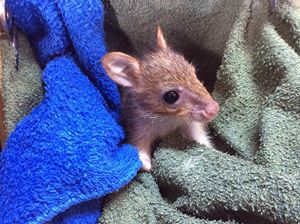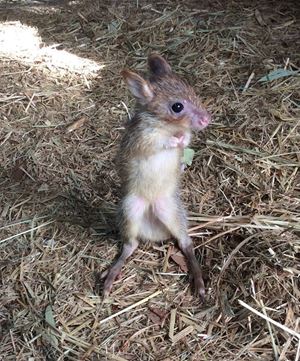A very special Joey
Wednesday, April 17, 2019

Earlier this year WIRES received a call from someone in Northern NSW who had been handed a very tiny joey. The mother had been caught in a trap, and when she was released she quickly disappeared, leaving her joey behind.
Not sure what the animal was, she phoned WIRES, thinking it was a Potoroo. Initial photos were blurry and identification was difficult but once the little joey arrived in care it was clear what it was – a little female Rufous Bettong.
Listed as a vulnerable species in NSW, it is thought that their numbers are decreasing rapidly due to fox and cat predation along with habitat loss. WIRES has had only a handful of bettongs in care since 2014, with none for the last 3 years. Looking a little like a cross between a mouse or rat, a bandicoot, a possum, and a wallaby, the Rufous Bettong is part of the Rat kangaroo family or Potoroids, which also include Potoroos and Musky rat kangaroos.

The Rufous Bettong sleeps during the day in conical grass nests built on a shallow depression at the base of a grass tussock or a fallen log in relatively open forest with dense grassy cover.
Their long nails allow them to dig for their preferred diet of roots and tubers. They feed on grasses such as Blady Grass and various species of native herbs,tubers, roots, fungi and some insects.
An important part of their diet are native truffles, which are the spore-bearing bodies of underground fungi.
Those fungi associate with the rootlets of trees such as eucalypts, helping the tree to take up minerals from the soil. By digging up and eating the truffles, bettongs disperse those spores in their dung, helping the fungi to spread to new hosts. In that way bettongs play an important role in ecosystems.
Apart from mothers with young, they nest solitary in the wild. They have a prehensile tail which they use to carry grasses gathered for their multiple nest sites built by individual animals enabling them to flee to a new site should a predator approach.
Follow us on Instagram or Facebook for more rescue stories or sign up to our enews.
Recent Posts
WIRES launches its first wildlife rehabilitation centre - Mullyang
WIRES Emergency Response in the wake of ex-tropical cyclone Alfred
International Women’s Day Volunteer Spotlight: Shelley
Tropical Cyclone Alfred – Emergency Wildlife Advice
Interview with WIRES Training and Development
Celebrating Women in Science: The Journey of Holly, Wildlife Conservationist and WIRES Team Member
